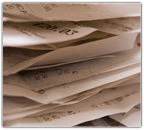 Change could open floodgates for contactless and other payment cards in vending, transit, unattended locations
Change could open floodgates for contactless and other payment cards in vending, transit, unattended locations
By Chris Corum, Editor
Regulation E, the rule outlining consumer rights with regard to electronic financial transactions, can make things tough on new payment offerings – but many argue that is its mission. Electronic payment providers have to make a slew of disclosures, they have to guarantee against fraudulent usage, they have to provide periodic statements, and they have to provide receipts for transactions. But this receipt requirement may be loosening. The Federal Reserve (Fed) is considering a change that would exempt transactions under $15 from the need to provide a receipt. Big deal you say? Read on.
Here is the Fed’s summary description:
“The Board is proposing to amend Regulation E, which implements the Electronic Fund Transfer Act … The proposed amendments would create an exception for certain small-dollar transactions from the requirement that terminal receipts be made available to consumers at the time of the transaction.”
What was some of the justification suggested for the change?
Consumers are using electronic payments where they used to use cash as the dollar value ‘threshold’ for card payments has been lowering in consumer eyes. The idea is that consumers ‘want’ to use cards to pay for things that, in the past, would have required cash. Examples include vending machines, transit tickets, parking facilities, and other small ticket items and unattended locations.
According to the proposed rule change:
“Merchants, financial institutions and payment card associations have responded to the shift in consumer preferences towards non-cash methods of payment for small-dollar transactions in various ways. Payment card associations have changed their rules to enable quicker processing of transactions for both debit and credit cards. For example, these associations have waived the signature and personal identification number (PIN) authorization requirements for certain types of purchases under $25. Moreover, to encourage merchant acceptance of payment cards, these associations have also reduced their debit and credit card interchange rates for certain small-dollar transactions. In addition, some card issuers have integrated new technologies into their products which allow consumers to swipe or wave radio frequency-enabled cards or other devices to authorize payment in “contactless” transactions. These initiatives have reduced the amount of time consumers spend at checkout, which has in turn allowed merchants to process more transactions in the same amount of time.”
Arguments for and against the change …
The comment period on the proposed change ended on January 30, 2007, and more than 30 comments were received in response to the proposed changes. As one might expect, consumers submitting comments tended to react negatively to the proposed change while industry came down in favor of the change. Of course, this should, in no way, be deemed a true representation of either group’s opinion as only those with a vested interest or extremely strong opinions are likely to take the time to comment.
The arguments against the proposed change centered on the following themes:
Arguments in favor of the change centered around the fact that this could help to open up the use of the payment cards at new locations and venues, to the benefit of the modern consumer.
Additionally, many industry comments suggest that the threshold for the receipt exception be raised from $15 to $25:
David DeMedio, commented as a representative of USA Technologies, a leading manufacturer of payment readers for unattended devices. He explained the potentially insurmountable challenges to providing receipts at many unattended devices:
“Deploying a credit/debit payment option, with the requirement to provide a receipt, would be a major, if not insurmountable impediment to industry wide acceptance. In vending, for example, many of the makes and models of the estimated 8 million vending machines installed in the U.S. do not have the required space to accommodate the additional receipt printer and paper roll. Also, since the newly introduced contactless credit/debit readers utilize the existing, available power from the host vending machine, adding a receipt printer would now require an additional power source to power the printer.“
He also addressed the service challenges that we have all likely experienced when trying to get a receipt from unattended gas pumps, stating:
“Significant servicing issues arise with offering receipts because of the unattended, distributed nature of these machines and the infrequency in which they are serviced. Malfunctioning printers, empty paper rolls and litter from discarded receipts, which could go uncorrected for the reasons above, could actually cause the consumer to have a negative experience while purchasing from the machine, thereby negating the purpose to install the printers in the first place.”
What happens next?
According to a spokesperson for the Federal Reserve, the proposed change will follow an established process. Staff will review the comments and consider them as they prepare a final recommendation. This will be presented to a Board committee for consideration and, if approved, will be presented to the Board of Governors for final consideration.
Though a timeline is not available, other proposed changes have taken as long as eighteen months from start to finish. Several things, however, work in favor of this change being accepted or rejected in a more rapid period. First, it is the only proposed change to Reg E currently under consideration. Second, it is fairly straightforward issue for consideration and does not possess the degree of complexity of many other proposals.
Stay tuned.
Additional resources:
To download a copy of the proposed rule change as published in the Federal Register on December 1, 2006, click here.
To view comments submitted for consideration by the Board, click here.




